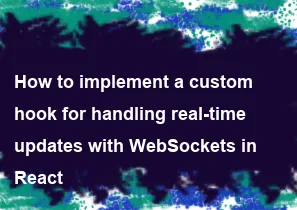How to implement a custom hook for handling real-time updates with WebSockets in React

To implement a custom hook for handling real-time updates with WebSockets in React, you can create a hook that manages the WebSocket connection and provides functions to send and receive messages. Here's a basic example of how to create such a custom hook:
jsximport { useEffect, useRef, useState } from 'react';
const useWebSocket = (url) => {
const [messages, setMessages] = useState([]);
const webSocketRef = useRef(null);
useEffect(() => {
// Create WebSocket connection
webSocketRef.current = new WebSocket(url);
// Event handler for incoming messages
webSocketRef.current.onmessage = (event) => {
const message = JSON.parse(event.data);
setMessages((prevMessages) => [...prevMessages, message]);
};
// Clean up WebSocket connection
return () => {
webSocketRef.current.close();
};
}, [url]);
// Function to send messages
const sendMessage = (message) => {
if (webSocketRef.current.readyState === WebSocket.OPEN) {
webSocketRef.current.send(JSON.stringify(message));
}
};
return { messages, sendMessage };
};
export default useWebSocket;
In this custom hook:
url: The URL of the WebSocket server.messages: An array of received messages.sendMessage: A function to send messages to the WebSocket server.
You can then use this custom hook in your components like this:
jsximport React, { useState } from 'react';
import useWebSocket from './useWebSocket';
const Chat = () => {
const [inputValue, setInputValue] = useState('');
const { messages, sendMessage } = useWebSocket('ws://localhost:8080');
const handleChange = (event) => {
setInputValue(event.target.value);
};
const handleSubmit = (event) => {
event.preventDefault();
sendMessage({ text: inputValue });
setInputValue('');
};
return (
<div>
<ul>
{messages.map((message, index) => (
<li key={index}>{message.text}</li>
))}
</ul>
<form onSubmit={handleSubmit}>
<input type="text" value={inputValue} onChange={handleChange} />
<button type="submit">Send</button>
</form>
</div>
);
};
export default Chat;
In this example, the Chat component uses the useWebSocket hook to manage the WebSocket connection and handle sending and receiving messages. Adjust the hook and component logic according to your specific use case and WebSocket server implementation.
-
Popular Post
- How to optimize for Google's About This Result feature for local businesses
- How to implement multi-language support in an Express.js application
- How to handle and optimize for changes in mobile search behavior
- How to handle CORS in a Node.js application
- How to use Vue.js with a UI framework (e.g., Vuetify, Element UI)
- How to configure Laravel Telescope for monitoring and profiling API requests
- How to create a command-line tool using the Commander.js library in Node.js
- How to implement code splitting in a React.js application
- How to use the AWS SDK for Node.js to interact with various AWS services
- How to use the Node.js Stream API for efficient data processing
- How to implement a cookie parser middleware in Node.js
- How to implement WebSockets for real-time communication in React
-
Latest Post
- How to implement a dynamic form with dynamic field styling based on user input in Next.js
- How to create a custom hook for handling user interactions with the browser's device motion in Next.js
- How to create a custom hook for handling user interactions with the browser's battery status in Next.js
- How to implement a dynamic form with dynamic field visibility based on user input in Next.js
- How to implement a dynamic form with real-time collaboration features in Next.js
- How to create a custom hook for handling user interactions with the browser's media devices in Next.js
- How to use the useSWRInfinite hook for paginating data with a custom loading indicator in Next.js
- How to create a custom hook for handling user interactions with the browser's network status in Next.js
- How to create a custom hook for handling user interactions with the browser's location in Next.js
- How to implement a dynamic form with multi-language support in Next.js
- How to create a custom hook for handling user interactions with the browser's ambient light sensor in Next.js
- How to use the useHover hook for creating interactive image zoom effects in Next.js